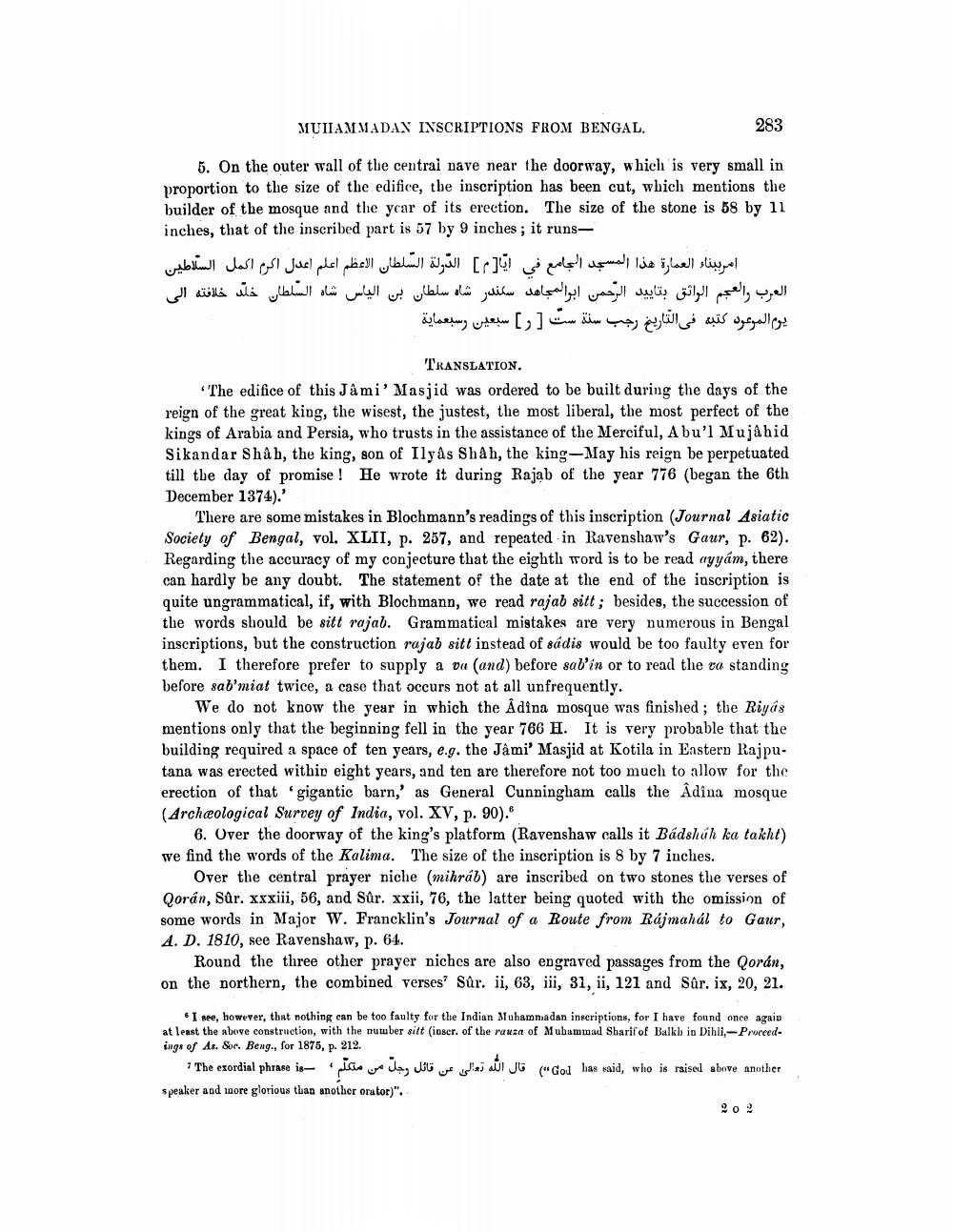________________
MUILAMMADAX INSCRIPTIONS FROM BENGAL.
283
5. On the outer wall of the centrai nave near the doorway, which is very small in proportion to the size of the edifice, the inscription has been cut, which mentions the builder of the mosque and the year of its erection. The size of the stone is 58 by 11 inches, that of the inscribed part is 57 by 9 inches; it runs
الدولة السلطان الاعظم اعلم اعدل اکرم اکمل السلاطين امر ببناء العمارة هذا المسجد الجامع في ايام
خند خلافته الى
شاه السلطان العرب والعجم الرائق بتائید الرحمن ابوالمجاهد سکندر شاه سلطان بن الياس يوم الموعود كتبه في التاريخ رجب سنة ست [ر] سبعين وسبعماية |
TRANSLATION. "The edifice of this Jami' Masjid was ordered to be built during the days of the reign of the great king, the wisest, the justest, the most liberal, the most perfect of the kings of Arabia and Persia, who trusts in the assistance of the Merciful, Abu'l Mujahid Sikandar Shah, the king, son of Ilyas Shah, the king-May his reign be perpetuated till the day of promise! He wrote it during Rajab of the year 776 (began the 6th December 1374).'
There are some mistakes in Blochmann's readings of this inscription (Journal Asiatic Society of Bengal, vol. XLII, p. 257, and repeated in Ravenshaw's Gaur, p. 62). Regarding the accuracy of my conjecture that the eighth word is to be read ayyam, there can hardly be any doubt. The statement of the date at the end of the inscription is quite ungrammatical, if, with Blochmann, we read rajab sitt; besides, the succession of the words should be sitt rajab. Grammatical mistakes are very numerous in Bengal inscriptions, but the construction rajab sitt instead of sádis would be too faulty even for them. I therefore prefer to supply a va (and) before sab'in or to read the va standing before sab'miat twice, a case that occurs not at all unfrequently.
We do not know the year in which the Âdina mosque was finished; the Riyas mentions only that the beginning fell in the year 766 H. It is very probable that the building required a space of ten years, e.g. the Jami' Masjid at Kotila in Eastern Rajputana was erected within eight years, and ten are therefore not too much to allow for the erection of that gigantic barn,' as General Cunningham calls the Âdîna mosque (Archeological Survey of India, vol. XV, p. 90).
6. Over the doorway of the king's platform (Ravenshaw calls it Badshah ka takht) we find the words of the Kalima. The size of the inscription is 8 by 7 inches.
Over the central prayer niche (mihráb) are inscribed on two stones the verses of Qorán, Sür. xxxiii, 56, and Sûr. xxii, 76, the latter being quoted with the omission of some words in Major W. Francklin's Journal of a Route from Rájmahal to Gaur, A. D. 1810, see Ravenshaw, p. 64.
Round the three other prayer niches are also engraved passages from the Qorán, on the northern, the combined verses Sur. ii, 63, iii, 31, ii, 121 and Sûr, ix, 20, 21.
6 I see, however, that nothing can be too faulty for the Indian Muhammadan inscriptions, for I have found once again at least the above construction, with the number sitt (inscr. of the rauza of Muhammad Sharif of Balkb in Dihli.-Proceedings of As. Soc. Beng., for 1875, p. 212.
* The exordial phrase is, have no way do wf Wisal JG (“God has said, who is raised above another speaker and more glorious than another orator)".




